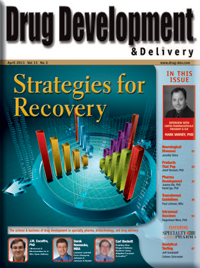issues
April 2011
Download PDFTABLE OF CONTENTS
Lessons Learned From Genzyme, Johnson & Johnson & Baxter
Derek G. Hennecke, MBA, sets off his newest 6-part series on how not to blow the recovery!
Oral Administration Remains the Most Used & Preferred Drug Delivery Method for Neurological Diseases
Frost & Sullivan Analyst Jennifer Brice indicates that although oral administration is expected to continue to be the preferred form of drug delivery for neurological diseases, there seems to be increasing interest in transdermal delivery.
Drug Delivery: Products That Pop
Josef Bossart, PhD, examines several products that “pop” and tries to understand what makes them different and special.
Defining & Addressing Solid-State Risks After the Proof-of-Concept Stage of Pharmaceutical Development
Joanna Bis, PhD, and David Igo, PhD, indicate that although the significance of solid form selection is generally well appreciated across the pharmaceutical industry, strategies can vary widely between different drug development programs as companies attempt to balance the tension between quality, speed, cost, and risks.
Analysis of New FDA Transdermal Draft Guidances: Insights on Study Design for Bioequivalence Assessment of Transdermal Systems
Paul A. Lehman, MSc, says that since 2007, the US FDA has issued 12 bioequivalence draft guidances for generic transdermal patch designs, and while they provide insight into current regulatory views on study designs for individual transdermal patch bioequivalence assessments, differences among the guidances make it challenging for product developers to glean essential principles for study design.
Ultrasound & Microbubbles for In Vitro Gene Delivery
J.M. Escoffre, PhD; A. Novell, MSc; A. Zeghimi, MSc; and A. Bouakaz, PhD; focuses on the mechanisms of membrane permeabilization with ultrasound and microbubbles and its use for in vitro gene delivery.
2011 DDP Awards Indicate Traditional Drug Delivery Model Isn’t Dead
In this post-show wrap-up of the Drug Delivery Partnerships Conference, Marc Dresner highlights the companies recognized for establishing successful relationships with their partners!
Do We Need New Devices for Intranasal Vaccination?
Degenhard Marx, PhD, Matthias Leitz, and Christophe Fagot believe intranasal vaccination, used successfully in veterinary medicine for years, provides a promising non-invasive alternative that should transfer across to use in humans and may gain a reasonable share of the market in the near future.
Covaris: Enabling New Drugs & Delivery Systems Using Adaptive Focused Acoustics
Drug Development Executive: Carl Beckett, Covaris Flow Division General Manager, discusses how AFA is enabling new drug delivery systems.
Heavy Metals Testing (USP<231>) Revisions: New Limits & Procedures for Elemental Impurities in Pharmaceuticals & Dietary Supplements
Jeff Grindstaff and Colleen Schroeder indicate changes to heavy metals test procedures for the analysis of pharmaceuticals and dietary supplements are under review with new standards set to be in place by mid-2013, and the intent of this discussion is to update current analytical testing historically performed using USP<231>.
Cortex Pharmaceuticals: Developing Novel Drug Therapies for the Treatment of Neurological & Psychiatric Disorders
Executive Summary: Mark Varney, President & CEO of Cortex Pharmaceuticals, talks about a development that may very well offer hope to those who are experiencing the symptoms associated with PD, Fragile X, ADHD, and apnea. In particular, he describes the advent of a class of molecules called AMPAKINE compounds.
COVER
FEATURES


















